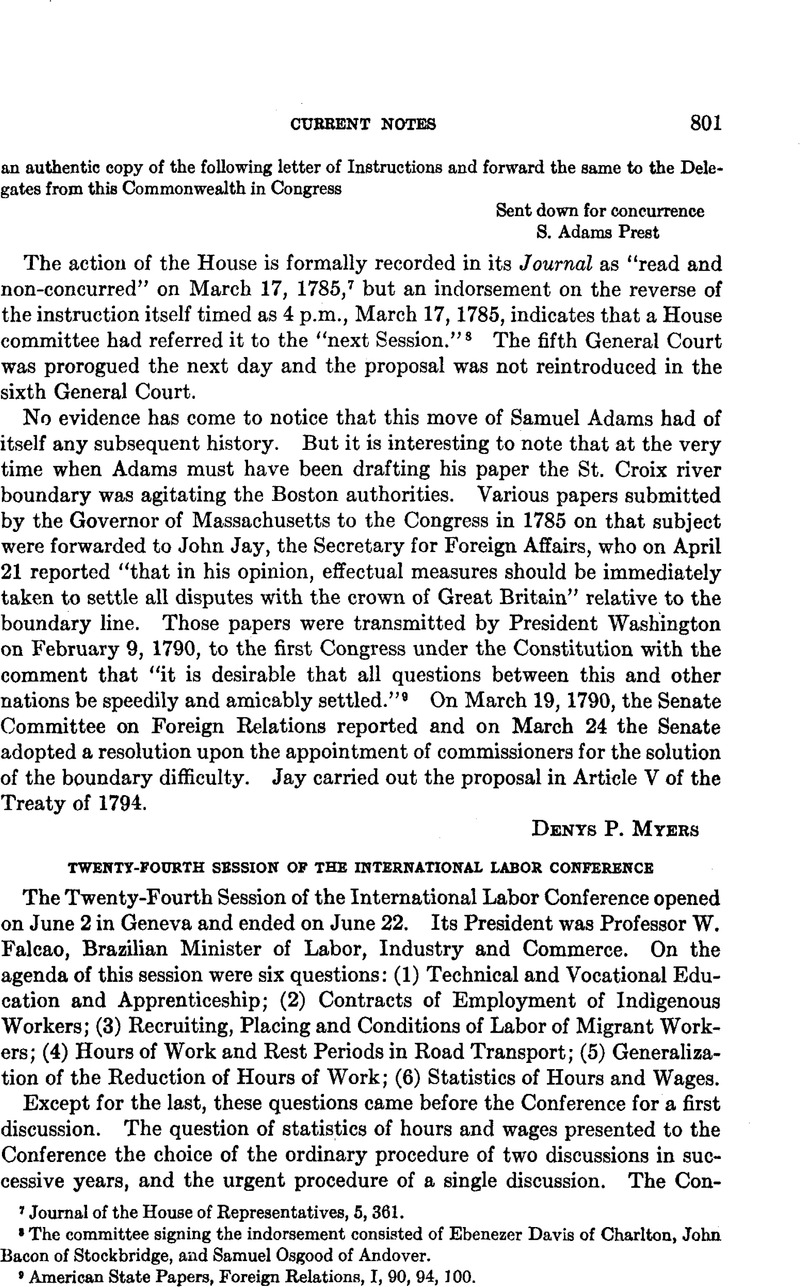No CrossRef data available.
Published online by Cambridge University Press: 12 April 2017

1 Provisional Record, Int. Labor Conference, Twenty-Fourth Session, Geneva, No. 25, pp. 342–3.
2 Part II. The text of the Convention as reported by the Drafting Committee and subsequently adopted without change by the Conference will be found in Prov. Rec., op. cit., No.19, Appendix.
3 Part III.
4 Part IV.
5 Part I, Art. 2.
6 Id., Art. 4.
7 Id., Art. 23.
8 Prov. Rec., No. 21, p. 303. For text of the resolution, see ibid., No. 17, p. XXXI.
9 Ibid., No. 21, p. 303. For text of the resolution, see ibid., No. 17, p. XXX.
10 Ibid., No. 21, p. 303. For text of the resolution, see ibid., No. 17, p. XXX.
11 See Wages and Hours of Work in the Coal-Mining Industry, Int. Labor Office, Studies and Reports, Series D, No. 18 (Geneva, 1928), Preface, especially at pp. XIV–XV.
12 World Textile Industry, Int. Labor Office, Studies and Reports, Series B, No. 27 (Geneva, 1937), p. 275.
13 See The World Textile Industry, White Report to the Technical Tripartite Conference, Washington, April, 1937 (Geneva, 1937), Proof Edition Foreword. The Foreword of the White Report is reproduced in The World Textile Industry, Studies and Reports, No. 27, op. cit., Vol. I, Introduction.
14 Report of the Committee on Statistics, Technical Tripartite Conference on the Textile Industry, Washington, 1937, C.T.T.F./D.ll, 15.4.37 (Mimeographed). Reproduced in The World Textile Industry, Studies and Reports, No. 27, op. cit., Vol. II, p. 273 ff.
15 See second report of the Committee on Statistics, Int. Labor Conference, Twenty-Fourth Session, Prov. Rec., No. 17.
16 Int. Labor Conference, Fourteenth Session, Geneva, 1930, Record of Proceedings, p. 480.
17 Int. Labor Conference, Twentieth Session, Geneva, 1936, Record of Proceedings, p. 399.
18 See the memorandum submitted by the Int. Labor Office to the Assembly of the League of Nations, reprinted in International Labor Review, Vol. XXXVI, No. 6 (December, 1937), p. 721 ff.
19 Provisional Record, op. cit., No. 25, p. 344.
20 Ibid., No. 22, p. 328.
21 For a review of the development of the hours program of the I.L.O., see Smith Simpson “What Hours To Work,” American Labor Legislation Review, Vol. XXVIII, No. 2 (June, 1938), p. 79 ff.
22 Prov. Rec., op. cit., No. 29, p. 446.
23 Ibid., No. 25, p. 332.
24 Ibid., p. 334.
25 Ibid., p. 335.
26 Ibid., p. 338.
27 Ibid.
28 Int. Labor Conference, Twenty-Fourth Session, Report of the Director, Chap. V.
29 Int. Labor Conference, Twenty-Fourth Session, Report of the Director, at p. 71.
30 Ibid,., at p. 74.
31 Prov. Rec., op. cit.. No. 8. p. 49 ff.
32 Ibid., No. 8, p. 60.
33 Ibid., No. 12, p. 191.
34 Ibid.
35 Ibid.
36 Ibid.
37 Ibid.
38 Ibid. No. 11, p. 171; No. 12, p. 190; No. 13, pp. 226, 238 and 239. The election of John G. Winant to the Directorship of the Office strikingly reflects the increasing vigor of participation in the Organization by American countries; and the election was viewed by delegates to the Conference as cementing the ties of the Organization to the Conference. Ibid., No. 10, p. 137.
39 Ibid., No. 10, p. 114.
40 Prov. Rec., op. cit.. No. 11. 172.
41 Ibid.. No. 13. p. 243.
42 “What Hours To Work,” loc. cit.
43 Convention No. 43. Int. Labor Conference, Eighteenth Session, Geneva, 1934, Record of Proceedings, p. 286. This convention had quite a different origin from the hours conventions adopted subsequently. It began not in an effort to combat unemployment but to provide a weekly rest in undertakings using tank furnaces. The phenomenal growth of automatic machinery during the late 1920’s completely altered the kind of undertakings to which the proposed convention was finally made applicable. The weekly-rest approach also was supplemented by the desire to provide compensation for overtime.
44 Convention No. 49. Int. Labor Conference, Nineteenth Session, Geneva, 1935, Record of Proceedings, p. 691.
45 Convention No. 51. Int. Labor Conference, Twentieth Session, Geneva, 1936, Record of Proceedings, p. 444.
46 Convention No. 61. Int. Labor Conference, Twenty-Third Session, Geneva, 1937, Record of Proceedings, pp. 508–509.
47 For the text of the resolution (submitted by Mr. Mertens, Belgian Workers’ Delegate, and Mr. Jouhaux, French Workers’ Delegate), see Int. Labor Conference, Twenty-Third Session, Record of Proceedings, p. 787. For the discussion and vote on the resolution, see ibid.. 402–496.
48 Prov. Rec.. No. 29. 449.
49 For comment on the situation at the Twentieth Session of the Int. Labor Conference, when the 40-hour conventions for the iron and steel, and coal industries were up for a record vote, see Smith Simpson, “The I.L.O. Month by Month,” American Federationist, Vol. 43, No. 8 (August, 1936), pp. 825–6. See also Report of the Director, 1938, op. cit., especially at p. 56.
50 Ibid., Chap. I: “Prosperity Regained—and Lost?”